The Intel Haswell Refresh Review: Core i7-4790, i5-4690 and i3-4360 Tested
by Ian Cutress on May 11, 2014 3:01 AM ESTReal World Benchmarks
2D to 3D Rendering –Agisoft PhotoScan v1.0: link
Agisoft Photoscan creates 3D models from 2D images, a process which is very computationally expensive. The algorithm is split into four distinct phases, and different phases of the model reconstruction require either fast memory, fast IPC, more cores, or even OpenCL compute devices to hand. Agisoft supplied us with a special version of the software to script the process, where we take 50 images of a stately home and convert it into a medium quality model. This benchmark typically takes around 15-20 minutes on a high end PC on the CPU alone, with GPUs reducing the time.
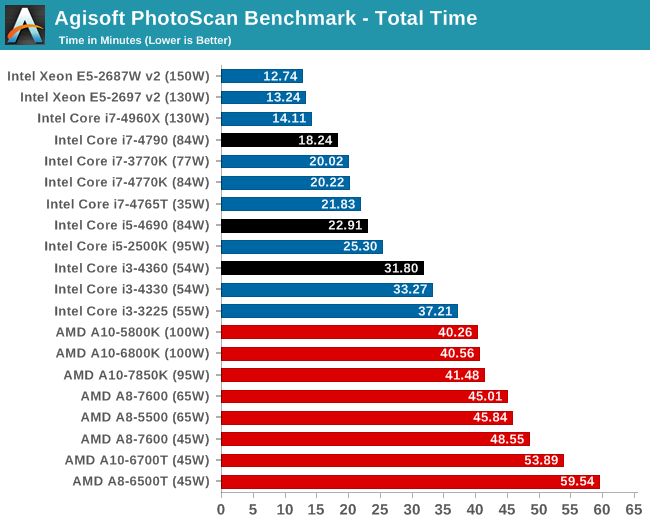
For Photoscan we see the incremental speedup with the i3 models, but the increased single thread speed of the i7 makes more of a difference.
Compression – WinRAR 5.0.1: link
Our WinRAR test from 2013 is updated to the latest version of WinRAR at the start of 2014. We compress a set of 2867 files across 320 folders totaling 1.52 GB in size – 95% of these files are small typical website files, and the rest (90% of the size) are small 30 second 720p videos.
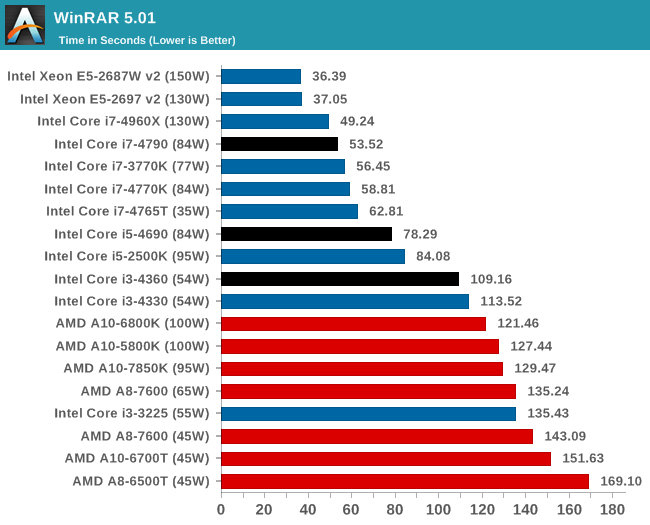
For WinRAR, the increase in the threads makes the most difference here, moving from i5-4690 to i7-4675T.
Image Manipulation – FastStone Image Viewer 4.9: link
Similarly to WinRAR, the FastStone test us updated for 2014 to the latest version. FastStone is the program I use to perform quick or bulk actions on images, such as resizing, adjusting for color and cropping. In our test we take a series of 170 images in various sizes and formats and convert them all into 640x480 .gif files, maintaining the aspect ratio. FastStone does not use multithreading for this test, and thus single threaded performance is often the winner.
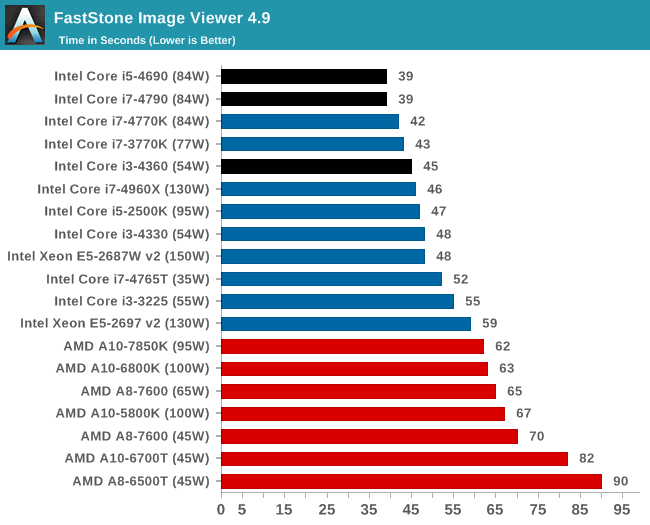
FastStone is all about the single thread speed.
Video Conversion – Xilisoft Video Converter 7: link
The XVC test I normally do is updated to the full version of the software, and this time a different test as well. Here we take two different videos: a double UHD (3840x4320) clip of 10 minutes and a 640x266 DVD rip of a 2h20 film and convert both to iPod suitable formats. The reasoning here is simple – when frames are small enough to fit into memory, the algorithm has more chance to apply work between threads and process the video quicker. Results shown are in seconds and time taken to encode.
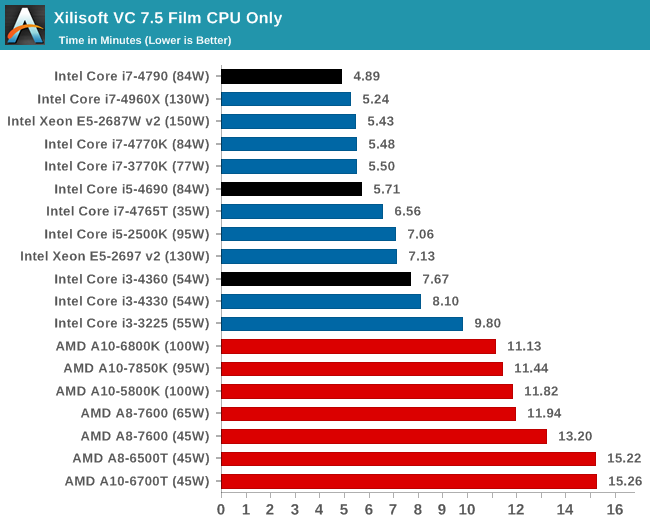
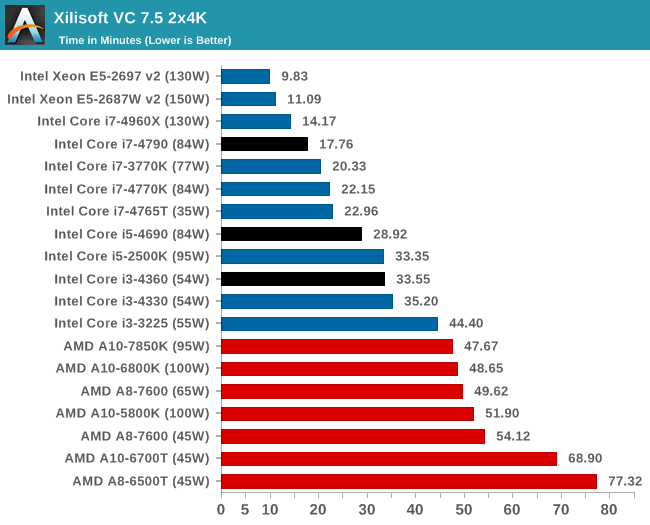
Small frames prefer more single thread MHz, whereas the dual 4K frame conversion prefers threads.
Video Conversion – Handbrake v0.9.9: link
Handbrake is a media conversion tool that was initially designed to help DVD ISOs and Video CDs into more common video formats. The principle today is still the same, primarily as an output for H.264 + AAC/MP3 audio within an MKV container. In our test we use the same videos as in the Xilisoft test, and results are given in frames per second.
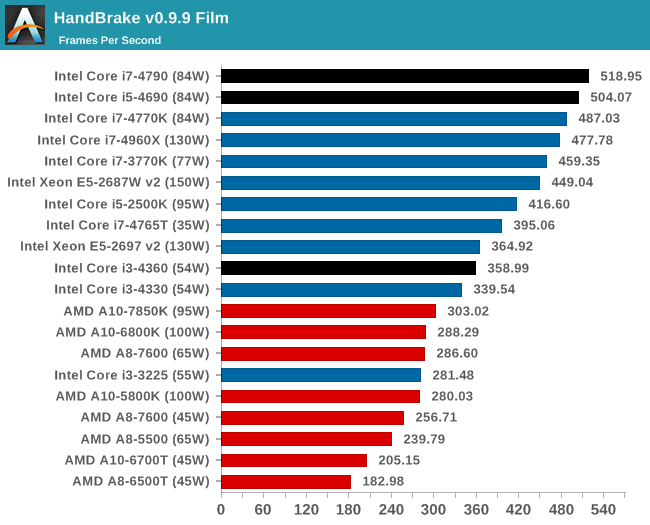
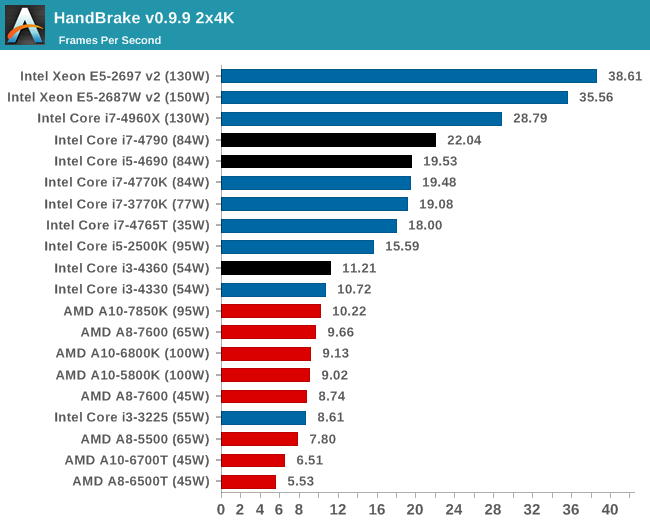
With Handbrake it would seem that it prefers actual cores rather than hyperthreading, given by the i5 and i7 being relatively close and 2x the i3.










130 Comments
View All Comments
MrSpadge - Monday, May 12, 2014 - link
Am I the only one to notice that especially in the first benchmarks the 4790 often outperforms the 4770K by ~6%, sometimes even by 11% (e.g. the very first benchmark)? Veryfiying an expected lack of improvement is nice, but not even commenting on such discrepancies seems.. not like usual Anandtech quality. If I were you I'd repeat those benchmarks and - if verified - would try to find the reason for the 4790 (sometimes) performing significantly better than expected.stephenbrooks - Saturday, May 24, 2014 - link
Yes, that's weird: the improvement is greater than the clock bump.RickyBaby - Monday, May 12, 2014 - link
So, would like to thank Ian on another job well done. A thankless job no doubt, as per the discussions this was a purely marketing driven release and offered essentially nothing of value. I did have one question though. And as background, I, like it appears most here are running and older, home built rigs like I am. Rigs built several generations ago which compete very well with today's rigs.I am an over-clocker from way back and like to squeeze out a little extra performance ... just to know that I haven't been cheated, lol. JK. Anyway, I'm thinking of buying a i3 and overclocking it what little I can or even go for an i5 - K chip. So, what overclocking options are available any more. ANY ???
The multi-core enhancement question for K processors was not answered in this article. Does it work on the 97 chipset with the new haswell's or not ??? And the does the limited bclk overclocking work ? Again, i3 (locked) and 97 chipset, does it work or not ? I'm sure that I'm not the only to realize that a 3.7 i3 with a bclk of 108 would be a cool 4.0 ghz. And that my friends is locked at 4.0. 1 cpu, 2 cpus, and even 3 and 4 via ht and all at 4.0 ghz. Since i5s and i7s throttle down depending on # CPUs being utilized ... up until more than 4, it seems that an i3 would kick ass. And here is where most could agree. Do I do ANYTHING that requires more than 4 cpus, 100% clocked at 4 ghz for large stretches of time ? NO. I. DO. NOT. And the difference in cache between an i3 (4mb) and an i7 (6mb) is again pretty much meaningless. Anyone know the diff in hit rates? 96% vs 97% ? So and even slightly overclocked i3 would make for an enticing $ proposition.
But this all gets ignored. Ian, care to address the overclocking situation in a follow up article ? And no, I'm not referring to Devils Canyon or the unlocked Pent; which is core limited (2, no HT) and cache limited. But for people who buy an non-K haswell. What options do they have and does it make a real difference ? I do wonder what intel would think if an i3 overclocked just a little bit would out perform every stock i5 and i7 though. Probably not a happy camper.
Antronman - Tuesday, May 13, 2014 - link
K series is core unlocked. Overclock it or underclock it to any clock rate you want.Non-K is core locked, you can only use turbo boost which is a very small increase in clock.
RickyBaby - Tuesday, May 13, 2014 - link
Sorry but you didn't answer the question. Can anyone ? Or is this some sort of no-no answer that everyone is supposed to give to satisfy the GIANT in the room. That GIANT of course being Intel.So why the confusion? Here is why, Toms just did a roundup of some of the new mobos and addresses overclocking. On that section (page 23 I believe) there are 3 charts. The middle chart gives the maximum base clocks for each of the motherboards on each of the 3 strap settings. The Gigabyte mobo reached a bclock of 114 with the strap set to 100. Which is the default and is unchangeable on non-k chips. You cannot change the strap but I do believe that you can change the clock. Would that not be a 14% overclock. If not, why not. The comment on the the Tom's page again seems to imply but not out and out claim you could overclock ANY locked CPU by 14% using that board. Here is exactly what he said:
"the Z79X Gaming 5 reached the highest base clock frequency when using the 100 MHz strap. That’s the only ratio available on multiplier-locked processors, so this might be important to anyone running the new Core i7-4790"
Why would that be important ? Because the 4790 is not a K and is therefore locked. But you could still overclock it by 14% .. which is how I read that.
And Tom's again muddies the waters. In that same article in review of the ASUS board on the 3rd page it talks about bios settings for overclocking and the use of the XMP setting. Again a quote:
"Unless you're using a K-series CPU, overclocking is limited to a handful of 100 MHz speed bins over stock. So, we reverted to our Core i7-4770K to test it."
So does XMP, multi-core enhancement still exist and still work for NON-K cpus ? Apparently it does. With the latest chipset (97) and latest chips (4th gen) too.
Sorry but I wish someone would just come out and say it. If your board supports BCLK increases then you can overclock to that amount. Not that is not a lot; most boards i've seen are 5%-7%. And if your chips supports Turbo then XMP/Mult Core Ehancement is alive and well too. So take an i5, increase bck by 10% and lock your Max Turbo using XMP and you'd have a decent overclock of 15%-20% under a heavy load.
I'm just waiting for someone (like Ian) to confirm/deny that the above is true.
MrSpadge - Tuesday, May 13, 2014 - link
Ricky, your concern is very valid! When Haswell launched I had hoped to get i7 4770R with Crystalwell L4 cache and to be able to set all cores to 3.9 GHz (max single core turbo), unlimited power consumption and a BCLK of 102.5 - 107.5 MHz for 4.0 - 4.2 GHz. This could run at very energy efficient ~1.00 V and would outperform pretty much every other quad core if the L4 works well (>10% performance per clock) and otherwise still be decent. Without any heat problems (power consumption would probably be below a stock 4770).BUT there were reports of multi core enhancement not working for non-K models. Which renders such a plan useless, before I even get to the point that you can not buy 4770R soldered onto a regular mainboard (just those notebook-expensive mini boxes).
JokerProductions - Tuesday, May 13, 2014 - link
Still the same horrible 1150 socket, but now with a 2% performance gain. Yay! Still waiting on X99 and my 8 core.eanazag - Tuesday, May 13, 2014 - link
Finally some bench love. I see the scores are in the bench. I'd like to see some updates to what AMD is still selling as far as the bench apps tested. Like comparing the FX 8350 with the new Haswells gets rough with limited apps that line up.The|Hunter - Tuesday, May 13, 2014 - link
btw Intel confirmed Broadwell and Z87 compatibility back in September 2013;One intel ceo/rep said: "Broadwell is going to enable 2 types of devices, One you can plug the chips directly into existing systems (z87) and Second we will have brand new systems with broad new range of fanless designs.."
https://www.youtube.com/watch?feature=player_detai...
*z87 and devil canyon needed IMEI uefi firmware update..
jjjag - Wednesday, May 14, 2014 - link
Desktops ARE dying. Stop saying they are not. Desktop silicon is exactly the same as mobile silicon, and has been for several generations. The number of SKUs that are sold into desktop has been rapidly declining, driven by the declining number of desktop computers that are offered by people like Dell and HP, which of course is driven by demand.HEDT, a.k.a. "Extreme", is different silicon than mobil/desktop since the 2nd gen. Core parts. These are server parts that are de-featured and re-badged as desktop. The volumes are too small and declining to justify these for much longer.
To answer another's question: you will not see a desktop with Iris Pro until Broadwell. Unless you count that little Gigabyte box that uses the Haswell Iris Pro.
To respond to another. Intel is not sabotaging anything. To believe that is ignorant. It's all driven by demand. Once demand drops below a certain level, it does not make business sense to sell a particular part.